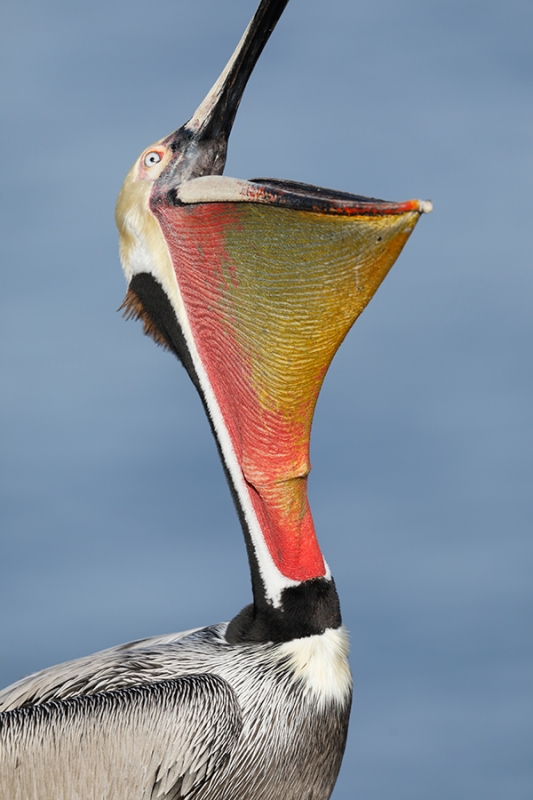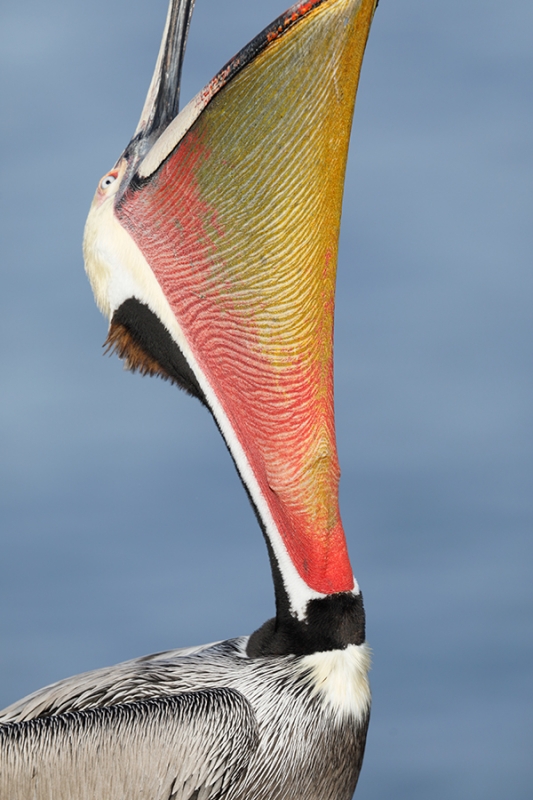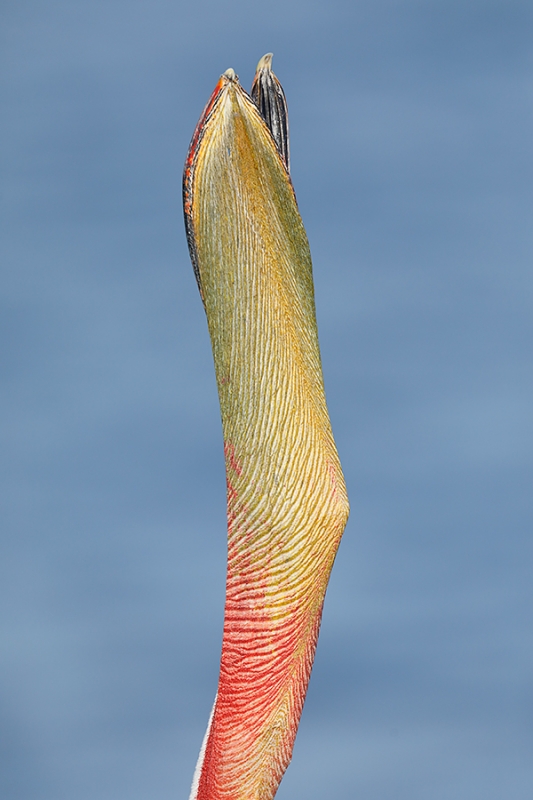What’s Up?
The San Diego IPT got off to a great start as the rain held off for most of the morning. We had lots of pelicans. Beautiful pelicans. Then I fed the group a helping displaying Brandt’s Cormorants. We had a nice lunch at Islands on Balboa and had a nice afternoon session with the harbor seals. The sunset was a grey fizzle. Now it is early to bed and early to rise for me.
Gear Questions and Advice
Too many folks attending BAA IPTs and dozens of folks whom I see in the field, and on BPN, are–out of ignorance–using the wrong gear, especially when it comes to tripods and more especially, tripod heads… Please know that I am always glad to answer your gear questions via e-mail.
The Streak: 426!
Today’s blog post marks a totally insane, irrational, illogical, preposterous, absurd, completely ridiculous, unfathomable, silly, incomprehensible, what’s wrong with this guy?, makes-no-sense, 426 days in a row with a new educational blog post. As always–and folks have been doing a really great job recently–please remember to use our B&H links for your major gear purchases. For best results use one of our many product-specific links; after clicking on one of those you can continue shopping with all subsequent purchases invisibly tracked to BAA. Your doing so is always greatly appreciated. Please remember: web orders only. And please remember also that if you are shopping for items that we carry in the new BAA Online Store (as noted in red at the close of this post below) we would of course appreciate your business.
|
|
|
This image was created at La Jolla, CA with the Induro GIT 304L/Mongoose M3.6-mountedCanon EF 500mm f/4L IS II USM lens, the Canon Extender EF 1.4X III, and my favorite bird photography camera, the Canon EOS 5D Mark IV. ISO 400. Evaluative metering +1/3 stop as framed: 1/1600 sec. at f/6.3 in Manual mode. Daylight WB. Four AF points up from the center AF point/AI Servo Expand/Shutter Button AF as framed was active at the moment of exposure. Click on the image to see a larger version. Brown Pelican (Pacific race) start of head throw |
Head Throw Photography
Photographing Brown Pelican head throws is a huge challenge. The birds do not do this behavior often. They usually do it quickly and without warning. The first frame or two when they stretch their bill pouch over their necks with the inside of their mouths exposed works best as a horizontal. Then you need to get to vertical, all the while changing the framing and maintaining focus. No matter how smart or skilled you are you will miss a lot more than you get. One of my very first BBC Wildlife Photographer of the Year Competition honored images was a full frame vertical of a killer breeding plumage Pacific race breeding plumage in the middle of a perfect head throw. On film yet.
Lens Too Long … Strike One.
It would have been great to have had the Canon 100-400mm II in my hands for this spectacular head throw. A gorgeous bird in gorgeous light. With a distant Pacific blue background. No wonder I was nervous. But for the first 2 images in the sequence. In any case, 700mm was way too long. Strike one.
|
|
|
This image was created at La Jolla, CA with the Induro GIT 304L/Mongoose M3.6-mountedCanon EF 500mm f/4L IS II USM lens, the Canon Extender EF 1.4X III, and my favorite bird photography camera, the Canon EOS 5D Mark IV. ISO 400. Evaluative metering +1/3 stop as framed: 1/1600 sec. at f/6.3 in Manual mode. Daylight WB. Four AF points up from the center AF point/AI Servo Expand/Shutter Button AF as framed was active at the moment of exposure. Click on the image to see a larger version. Brown Pelican (Pacific race) continuation of head throw |
Lens Too Long … Strike Two.
I was still dead in the water as far as framing was concerned … But I stayed with it trying to maintain focus somewhere.
|
|
|
This image was created at La Jolla, CA with the Induro GIT 304L/Mongoose M3.6-mountedCanon EF 500mm f/4L IS II USM lens, the Canon Extender EF 1.4X III, and my favorite bird photography camera, the Canon EOS 5D Mark IV. ISO 400. Evaluative metering +1/3 stop as framed: 1/1600 sec. at f/6.3 in Manual mode. Daylight WB. Four AF points up from the center AF point/AI Servo Expand/Shutter Button AF as framed was active at the moment of exposure. Click on the image to see a larger version. Brown Pelican (Pacific race) start of head throw |
Lens Just Long Enough: Home Run!
Suddenly everything came together for two frames. This, my favorite, was the last of the four-frame sequence.
|
Tame birds and wildlife. Incredible diversity. You only live once… |
GALAPAGOS Photo Cruise of a Lifetime IPT/The Complete Galapagos Photographic Experience. August 8-22, 2017 on the boat. 13 FULL and two half-days of photography: $12,499. Limit: 13 photographers plus the leader: yours truly. Openings: 4.
Same great trip; no price increase!
This trip needs nine to run; in the unlikely event that it does not, all payments to BAA will be refunded in full.
My two-week Galapagos Photo-Cruises are without equal. The world’s best guide, a killer itinerary, a great boat (the Samba), and two great leaders with ten Galapagos cruises under their belts. Pre-trip and pre-landing location-specific gear advice. In-the-field photo instruction and guidance. Jeez, I almost forgot: fine dining at sea!
The great spots that we will visit include Tower Island (including Prince Phillips Steps and Darwin Bay), Hood Island (including Punta Suarez, the world’s only nesting site of Waved Albatross, and Gardner Bay)—each of the preceding are world class wildlife photography designations that rank right up there with Antarctica, Africa, and Midway. We will also visit Fernandina, Puerto Ayora for the tortoises, Puerto Egas—James Bay, and North Seymour for nesting Blue-footed Boobies in most years, South Plaza for Land Iguanas, Floreana for Greater Flamingoes, and Urbina Bay, all spectacular in their own right. We visit every great spot on a single trip. Plus tons more. And there will be lots of opportunities to snorkel on sunny mid-days for those like me who wish to partake.
It is extremely likely that we will visit the incredible Darwin Bay and the equally incredible Hood Island, world home of Waved Albatross twice on our voyage. The National Park Service takes its sweet time in approving such schedule changes.
We will be the first boat on each island in the morning and the last boat to leave each island every afternoon. If we are blessed with overcast skies, we will often spend 5-6 hours at the best sites. And as noted above, mid-day snorkeling is an option on most sunny days depending on location and conditions. On the 2015 trip most snorkeled with a mega-pod of dolphins. I eased off the zodiac to find hundreds of dolphins swimming just below me. Note: some of the walks are a bit difficult but can be made by anyone if half way decent shape. Great images are possible on all landings with either a hand held 70-200mm lens and a 1.4X teleconverter or an 80- or 100-400. I sometimes bring a longer lens ashore depending on the landing. In 2017 I will be bring the Canon 400mm IS DO II lens. In the past I have brought either the 300mm f/2.8L IS II or the 200-400mm f/4 L IS with Internal Extender.
|
Do consider joining me for this once in a lifetime trip to the Galapagos archipelago. There simply is no finer Galapagos photography trip. Learn why above. |
An Amazing Value…
Do know that there are one week Galapagos trips for $8500! Thus, our trip represents a tremendous value; why go all that way and miss half of the great photographic locations?
The Logistics
August 6, 2017: We arrive in Guayaquil, Ecuador a day early to ensure that we do not miss the boat in case of a travel delay.
August 7, 2017: There will be an introductory Galapagos Photography session and a hands on exposure session at our hotel.
August 8, 2017: We fly to the archipelago and board the Samba. Heck, on the 2015 trip some people made great images at the dock in Baltra while our luggage was being loaded!
August 22, 2017: We disembark late morning and fly back to Guayaquil midday; most will overnight there.
Most will fly home on the early morning of July 23 unless they are staying on or going elsewhere (or catching a red-eye flight on the evening of the 22nd).
$12,499 includes just about everything: all transfers, guide and park fees, all food on the boat, transfers and ground transportation, your flights to the archipelago, and three nights (double occupancy) in a top notch hotel in Guayaquil. If you are good to go, a non-refundable deposit of $5,000 per person is due immediately. The second payment of $4,000 is not due until 11/1/16. The final payment of $3449 per person will be due on 2/1/17. A $200 discount will be applied to each of the balances for couples or friends who register at the same time.
Purchasing travel insurance within 2 weeks of our cashing your deposit check is strongly recommended. On two fairly recent cruises a total of 5 folks were forced to cancel less than one week prior to the trip. My family and I use Travel Insurance Services and strongly recommend that you do the same.
Not included: your round trip airfare from your home to and from Guayaquil, beverages on the boat, phone calls, your meals in Guayaquil, personal items, and a $600/person cash tip for the crew and the guide—this works out to roughly $40/day to be shared by the 7 folks who will be waiting on us hand and foot every day for two weeks. The service is so wonderful that many folks choose to tip extra.
Please e-mail for the tentative itinerary or with questions. Please cut and paste “Galapagos 2017 Tentative Itinerary Please” into the Subject line.
Please Remember to use my Affiliate Links and to Visit the New BAA Online Store 🙂
To show your appreciation for my continuing efforts here, we ask, as always, that you get in the habit of using my B&H affiliate links on the right side of the blog for all of your photo and electronics purchases. Please check the availability of all photographic accessories in the New BIRDS AS ART Online Store, especially the Mongoose M3.6 tripod head, Wimberley lens plates, Delkin flash cards and accessories, and LensCoat stuff.
As always, we sell only what I have used, have tested, and can depend on. We will not sell you junk. We know what you need to make creating great images easy and fun. And please remember that I am always glad to answer your gear questions via e-mail.
I would of course appreciate your using our B&H affiliate links for all of your major gear, video, and electronic purchases. For the photographic stuff mentioned in the paragraph above, and for everything else in the new store, we, meaning BAA, would of course greatly appreciate your business. Here is a huge thank you to the many who have been using our links on a regular basis and those who will be visiting the New BIRDS AS ART Online Store as well.
Be sure to like and follow BAA on Facebook by clicking on the logo link upper right. Tanks a stack.
Typos
In all blog posts and Bulletins, feel free to e-mail or to leave a comment regarding any typos or errors. Just be right :).



















Hi, Artie. A fine image indeed. I’ve wondered, though, why you don’t go a bit wider and expect to crop the image to your satisfaction with as many pixels as you have in the 5D Mark IV. You’d be trading off a small amount of image quality against a higher keeper rate, no?
By the way, I have been unable to figure out the meaning of your third sentence: “Then I fed the group a helping displaying Brandt’s Cormorants.”
We moved to a new spot and enjoyed photographing nesting Brandt’s Cormorants 🙂
Hard to go wider with a fixed 700mm lens 🙂
a
Glad to hear the rain is not slowing you down!
It has barely rained here. This morning was perfect with even a bit of sun. Thank God for inept weathermen 🙂
a